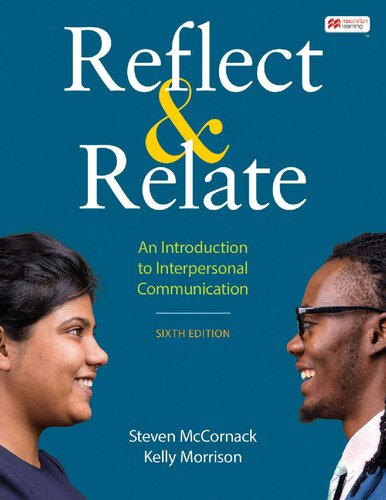Reflect Relate An Introduction to Interpersonal Communication 5th Edition by Steven Mccornack 9781319395827 1319395821
$50.00 Original price was: $50.00.$25.00Current price is: $25.00.
Reflect Relate An Introduction to Interpersonal Communication 5th Edition Steven Mccornack – Ebook Instant Download/Delivery ISBN(s): 9781319395827, 1319395821

Product details:
- ISBN 10:1319395821
- ISBN 13: 9781319395827
- Author: Steven Mccornack
Reflect & Relate
An Introduction to Interpersonal Communication
Current, inclusive, and authoritative, Reflect & Relate, Sixth Edition, has set the new standard for interpersonal communication texts. Steve McCornack and Kelly Morrison, both distinguished scholars and award-winning teachers, draw on their twenty-five years of classroom experience to connect classic and current communication theory and research to the actual lives of today’s students.
For the sixth edition, the authors built on their leading gender coverage by partnering with an advisory board of culturally responsive-sustaining pedagogy leaders to create an even more inclusive text that models for and guides students in culturally self-aware and inclusive communication. The revision features over 300 new scholarly citations, and responds to the real and growing interpersonal challenges students currently face: how to form positive relationships to support health and wellness, within increasingly online contexts, and with people who have a variety of backgrounds, abilities, and experiences. Additionally, coverage of mediated communication—its advantages, as well as its challenges—has been thoroughly updated to support students in today’s digital world.
LaunchPad for Reflect & Relate includes the full e-book along with powerful assessments, a full video library, LearningCurve adaptive quizzing, and Making Relationship Choices video activities to support you and your students—whether you are teaching face-to-face or online, synchronously or asynchronously.
Table contents:
Inside Front Cover
Making Relationship Choices videos take communication to the next level
Accessibility
Title Page
Copyright Page
Reflect & Relate, Sixth Edition, connects to the learning outcomes of the National Communication Association (NCA)
Preface
Brief Contents
Contents
The Editorial Board
The Authors
Chapter 1 Introducing Interpersonal Communication
What Is Communication?
Defining Communication
Understanding Communication Models
What Is Interpersonal Communication?
Defining Interpersonal Communication
Principles of Interpersonal Communication
Motives for Interpersonal Communication
What Is Interpersonal Communication Competence?
Understanding Competence
Improving Your Mediated Communication Competence
Issues in Interpersonal Communication
Culture
Focus on Culture: What Does Culture Mean to You?
Gender and Sexual Orientation
Technologically Mediated Communication
Challenging Issues in Interpersonal Relationships
The Journey Ahead
Making Relationship Choices: Dealing with a Difficult Friend
Chapter Review
Key Terms
Key Concepts
Chapter 2 Considering Self
The Components of Self
Self-Awareness
Self-Concept
Self-Esteem
Focus on Culture: How Does the Media Shape Your Self-Esteem?
The Sources of Self
Gender and Self
Family and Self
Culture and Self
Communicating Your Self
Maintaining Your Public Self
Disclosing Your Private Self
The Relational Self
Competently Disclosing Your Self
The Social Media Self
Self-Presentation on Social Media
Evaluating Social Media Self-Presentations
Improving Your Social Media Self-Presentation
Improving Your Self
Making Relationship Choices: Workplace Self-Disclosure
Chapter Review
Key Terms
Key Concepts
Chapter 3 Perceiving Others
Perception as a Process
Selecting Information
Organizing the Information You’ve Selected
Interpreting the Information
Reducing Uncertainty
Influences on Perception
Perception and Culture
Perception and Gender
Perception and Personality
Forming Impressions of Others
Constructing Gestalts
Calculating Algebraic Impressions
Stereotyping
Focus on Culture: Intersectional Stereotyping and U.S. Folk Music
Improving Your Perception
Offering Empathy
Checking Your Perception
Practicing Responsible Perception
Making Relationship Choices: Balancing Impressions and Empathy
Chapter Review
Key Terms
Key Concepts
Chapter 4 Experiencing and Expressing Emotions
The Nature of Emotion
Defining Emotion
Feelings and Moods
Focus on Culture: Happiness across Cultures
Types of Emotions
Forces Shaping Emotion
Personality
Gender
Managing Your Emotional Experience and Expression
Emotional Intelligence
Managing Emotions after They Occur
Preventing Emotions before They Occur
Reappraising Emotions while They Occur
Emotional Challenges
Anger
Text-Based Online Communication and Empathy Deficits
Passion
Grief
Living a Happy Emotional Life
Making Relationship Choices: Managing Anger and Providing Support
Chapter Review
Key Terms
Key Concepts
Chapter 5 Understanding Culture
Understanding Culture
Culture Defined
Co-Cultures
Co-Cultures and Communication
Focus on Culture: Is Social Media a Cultural Divide?
Prejudice
Cultural Influences on Communication
Individualism Versus Collectivism
Uncertainty Avoidance
Power Distance
High and Low Context
Emotion Displays
Masculinity Versus Femininity
Views of Time
Creating Intercultural Competence
World-Mindedness
Attributional Complexity
Communication Accommodation
Dismantling Divisions
Making Relationship Choices: Parent—Child Culture Clash
Chapter Review
Key Terms
Key Concepts
Chapter 6 Understanding Gender
Understanding Gender
Gender is Distinct from Sex and Gender Identity
Gender is Learned
Gender is Socially Constructed
Doing Gender
Considering Gender Roles
Gender and Communication
Focus on Culture: Gender Equity and Health
Gender and Verbal Communication
Gender and Nonverbal Communication
Gender and Relationships
Friendships
Romantic Relationships
Reflecting on Gender in Our Relationships
Moving Beyond Gender Stereotypes
Making Relationship Choices: Supporting a Gender-Nonconforming Friend
Chapter Review
Key Terms
Key Concepts
Chapter 7 Listening Actively
Listening: A Five-Step Process
Receiving
Attending
Understanding
Responding
Recalling
The Five Functions of Listening
Listening to Comprehend
Listening to Discern
Listening to Analyze
Listening to Appreciate
Focus on Culture: The Therapeutic Power of Listening to Music
Listening to Support
Adapting Your Listening Purpose
Listening Functions and Mediated Listening
Understanding Listening Styles
Four Listening Styles
Gender and Listening
Culture and Listening
Improving Listening Competence
Selective Listening
Eavesdropping
Pseudo-Listening
Aggressive Listening
Narcissistic Listening
The Gift of Active Listening
Making Relationship Choices: Listening When You Don’t Want To
Chapter Review
Key Terms
Key Concepts
Chapter 8 Communicating Verbally
Describing Verbal Communication
Language is Symbolic
Language is Governed by Rules
Language is Flexible
Language is Cultural
Language Evolves
Functions of Verbal Communication
Sharing Meaning
Shaping Thought
Naming
Focus on Culture: Adopting Gender-Inclusive Language
Performing Actions
Crafting Conversations
Managing Relationships
Cooperative Verbal Communication
Understandable Messages
Using “I” Language
Using “We” Language
Barriers to Cooperative Verbal Communication
Verbal Aggression
Deception
Defensive Communication
Communication Apprehension
The Power of Verbal Communication
Making Relationship Choices: Dealing with Difficult Truths
Chapter Review
Key Terms
Key Concepts
Chapter 9 Communicating Nonverbally
Describing Nonverbal Communicationn
Nonverbal Communication Differs from Verbal Communication
Nonverbal Communication is Influenced by Culture
Nonverbal Communication is Influenced by Gender
Nonverbal Communication is Liberated and Challenged by Technology
Nonverbal Communication Codes
Communicating through Body Movements
Communicating through Voice
Communicating through Touch
Focus on Culture: Touch and Distance
Communicating through Personal Space
Communicating through Physical Appearance
Communicating through Objects
Communicating through the Environment
Functions of Nonverbal Communication
Expressing Emotion
Conveying Meanings
Presenting Self
Managing Interactions
Defining Intimacy
Competently Managing Your Nonverbal Communication
Making Relationship Choices: Dealing with Mixed Messages
Chapter Review
Key Terms
Key Concepts
Chapter 10 Managing Conflict and Power
Conflict and Interpersonal Communication
What is Conflict?
Conflict in Relationships
Power and Conflict
Power’s Defining Characteristics
Power Currencies
Power and Gender
Handling Conflict
Approaches to Handling Conflict
Culture and Handling Conflict
Focus on Culture: Accommodation and Radical Pacifism
Handling Text-Based Conflict
Conflict Endings
Short-Term Conflict Resolutions
Long-Term Conflict Outcomes
Challenges to Handling Conflict
Self-Enhancing Thoughts
Destructive Messages
Serial Arguments
Physical Violence
Unsolvable Disputes
Managing Conflict and Power
Making Relationship Choices: Dealing with Family Conflict
Chapter Review
Key Terms
Key Concepts
Chapter 11 Relationships with Romantic Partners
People also search:
reflect relate an introduction
reflect & relate an introduction to interpersonal communication
reflect & relate an introduction to interpersonal communication pdf
how do you write an introduction to a reflection
does a reflection need an introduction
You may also like…
Politics & Philosophy - Government & Politics
dictionaries & phrasebooks
Business & Money
Uncategorized
Connect, Relate, Motivate: Master Communication in Any Situation 2nd Edition Rik Rushton
Uncategorized












